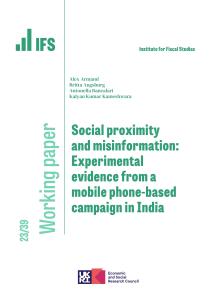Today the Social Metrics Commission, which I was a part of, has published its report on a new approach to poverty measurement in the UK. The Commission drew on a wide range of expertise, from academics and other researchers to those with experience of policy-making, the production of official statistics, and working to improve the lives of the most vulnerable. Importantly, this encompassed individuals and organisations with a variety of political complexions and none. This observation summarises and discusses the work of the Commission and the conclusions that it reached.
One of the reasons why I was pleased to join the Commission was that it was an important time for an attempt at developing coherent poverty measures which could maintain the support of a broad range of people. Recent history had been inglorious in this respect. The traditional, relatively straightforward poverty measures based on current household income had always been acknowledged as useful, but also incomplete and imperfect, proxies for identifying the worst off and tracking how they are faring over time. The coalition government that took office from 2010 judged these imperfections to be too great to persist with, or at least too great to be a significant driver of policy - but then produced a muddled attempt at a roadmap for a new way forward in a consultation (as we analysed here), and never reached agreement on a new measurement framework.
The Commission recommends a new measure for determining which people are currently in poverty, alongside complementary metrics to capture the depth of poverty, its persistence, and some of the wider disadvantages that can compound the experience of poverty. The proposed “headline” measure of poverty refines the traditional measures based purely on household income in a number of ways, to account better for the complexity and variety in people’s material circumstances. These include attempts to account for the financial costs of childcare and disability (as well as housing costs, which are already common to account for), holdings of accessible financial assets in addition to current flows of income, and inadequate housing. These have some significant impacts on our understanding of who is most likely to be in poverty with, for example, children and people with a disability making up a bigger share of those in poverty under the proposed new measure than the old one. A number of additional refinements are also recommended for the medium term contingent on improvements in data quality, such as the subtraction of debt repayment obligations from income.
Convincing evidence of the improvements that these changes bring about is in Figure 22 of the Commission’s report: it shows that the people who the new proposed measure classifies as being in poverty align more closely with those whose self-reported answers suggest that they are ‘materially deprived’ – that is, unable to afford a number of specific items. Among people who would be classified as in poverty under both the Commission’s new proposed measure and the ‘traditional’ after-housing-costs income measure, about 40% are also materially deprived. For those whom the old measure would have classified as in poverty but the Commission’s measure would not, only 10% are materially deprived; whereas of those not in poverty according to the traditional measure but in poverty according to the new proposed one, the figure is 32% - not so different from the material deprivation rate of those people who both measures agree are in poverty.
There are reasons not simply to use material deprivation directly as ‘the’ poverty measure: the choice of items is subjective; the items need to be updated every so often as social norms change and this makes comparisons over time difficult; and people’s perceptions of whether something is ‘affordable’ can depend on more than just their actual material position, including their own preferences about what to prioritise. But the fact that this entirely independent measure of material wellbeing aligns significantly more closely with the new proposed measure than the old one is encouraging.
The new proposed measure also tries to tackle the age-old tension between absolute and relative measures of poverty. On the one hand, the concept of poverty surely has a relative component: the minimum standard of living that a society deems acceptable depends on time and place and so, for example, is clearly different now from what it was in Victorian times. Hence a poverty line should move with the times. On the other hand, society’s intuitions about what constitutes an acceptable living standard are probably somewhat sticky: although they change, they probably do not change in real time with, for example, year-to-year volatility in median income. One of the criticisms of the standard poverty line of 60% of current median income is that poverty can fall sharply in a recession because median income – and hence the poverty line – falls, but this fall in the poverty line may be far greater than any real immediate change in what society thinks of as ‘poor’. In the short term, one might therefore want a poverty line that behaves more like an “absolute” line, i.e. that is not so acutely sensitive to current changes in median income.
With these points in mind, and after much deliberation over the details (set out in the Commission’s report), the Commission opted for a poverty line based on a ‘smoothed’ version of median income: 60% of the average of median income over the latest 3 years (as opposed to the traditional 60% of median income in the latest single year). Hence, the poverty line is unambiguously a relative one because it does change as society as a whole gets better or worse off. But the effects on the poverty line will only fully feed through if the change in median income is sustained (for at least 3 years), and even then will take 3 years to do so.
Finally I would point out two observations that my time on the commission underlined.
First, political wranglings sometimes mask a remarkable level of agreement on basic points. The discussion above provides an excellent example: it was striking how easily a consensus across the Commission was reached on the notion that i) poverty is a relative concept but ii) people’s definition of ‘poor’ probably doesn’t change in real time as quickly as something like average income.
Second, the act of trying to construct a measure of something almost invariably uncovers vagueness or imprecision in conceptual thinking about what that thing actually is. To get to any single poverty measure you have to make important and contestable judgements about what you are trying to incorporate within ‘poverty’ and what you are not - perhaps the main reason why I expect it will always be possible, or even easy, to take pot-shots at any single measure considered in isolation, and why it would never be sensible for one measure on its own to guide policy. One can almost never describe everything that is important about a complex issue – whether poverty, inflation, inequality, crime or pretty much anything else – in a single number. For example, it is extremely difficult to track both present hardship and resilience or prospects for the future within a single poverty measure, without having something that’s impossible to interpret. In that example the Commission decided it was trying to capture the former (while recommending that supplementary measures capture the latter). This guided a number of specific features of the proposed poverty measure, such as the treatment of wealth. Without agreement on some underlying principles to guide the myriad of subsequent decisions we made, we could easily have ended up with an incoherent mess. Think before you measure!
Note: We are grateful to the ESRC for supporting this activity through the Impact Acceleration Account (IAA) at IFS.








